July 2010
02.07.2010: Today we finished calibrating the fuel tanks. After that we made everything ready to run the engine for the first time. First we disconnected all the ignition cables and run the starter for about two seconds to see whether the oil pump works and develops sufficient oil pressure. We wanted to be sure before an engine start, as the Dynon EMS usually resets during cranking due to the drop in battery voltage, and it then takes a few seconds before one can see the engine parameters. After that we connected all the ignition cables and just tried starting the engine with a very short kick with the starter. To our surprise it started immediately, and ran smoothly without the slightest problem. Below a picture of the preparations.
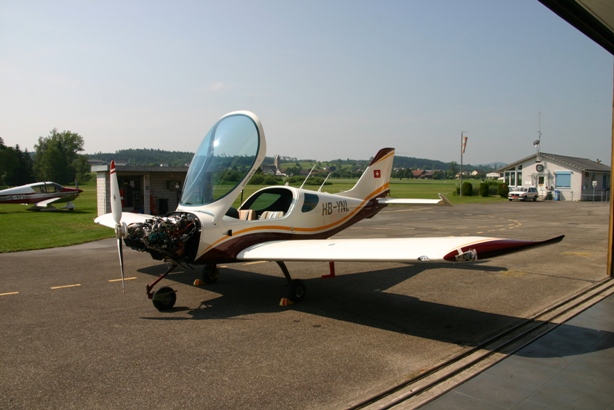
And here the engine running for the first time. Silvan was standing guard with a fire extinguisher, but fortunately we did not need it.

I then run the engine for some time, checking all the parameters again and again. Once the oil reached the required 50 o C I could run it to higher power.
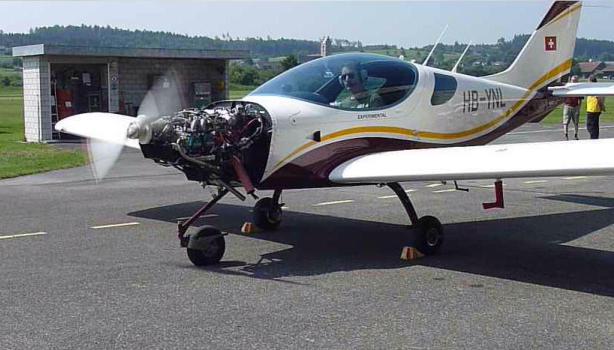
Silvan closely observed whether there were any leaks, but fortunately he did not find anything.
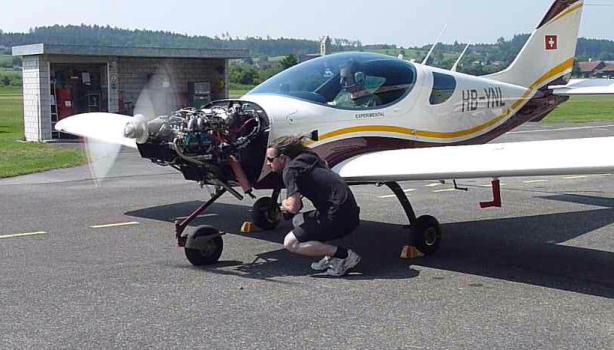
We then checked the tachometer of the Dynon by comparing it with a handheld optical instrument, and at that time I noticed that the reading was about 20 % wrong. After stopping the engine I went through the setup menu of the Dynon D120 EMS and found out that even though one can select the Rotax engine for basic setup one still has to set spme of the engine parameters manually. Others however are set automatically to the right values, including e.g. changing colour bands for the oil temperature once the oil reaches 50 oC, as specified in the Rotax manuals. Anyway, once I had corrected all the setting the tacho reading was working fine.
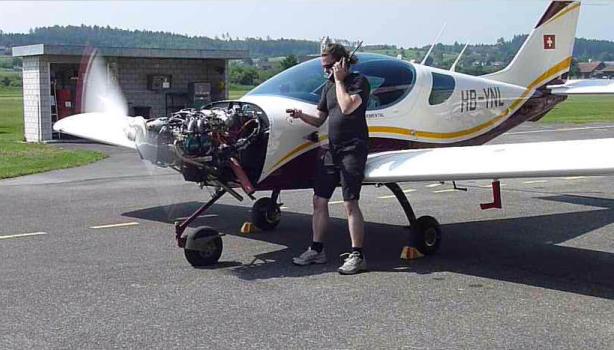
During our engine testing we had a rare aircraft visiting our airfield, a Dewoitine D.26 build under licence in Switzerland in 1931. Amazingly it still flies, even though it is 79 years. It does look small on the picture, but once parked next to a Piper or Cessna it’s size becomes visible.

03.07.2010: I spent a few hours today checking the rigging of the plane and finishing some of the paperwork. Once I looked outside I saw yet another homebuilt visiting our airfield. It was a Volksplane VP-1, below a picture taken at departure. A second Volksplane arrived also, but I forgot to take a picture.

04.07.2010: I finished nearly all the documents today for the final check by the EAS, which is planned for Tuesday evening. In the afternoon I went to the airport to make the fuel flow measurements, which is required by EAS. The purpose of the measurement is to prove that during takeoff the auxiliary fuel pump can supply sufficient fuel to the engine even if the main mechanical fuel pump fails. For that the plane first has to be brought into takeoff position, meaning pointing 16 degrees upwards.

That means it more or less sits on it’s tail. After that the fuel line leading to the carburettors has to be disconnected, an the auxiliary fuel pump activated. One can then measure how much fuel flows per minute by catching the fuel in a calibrated container.
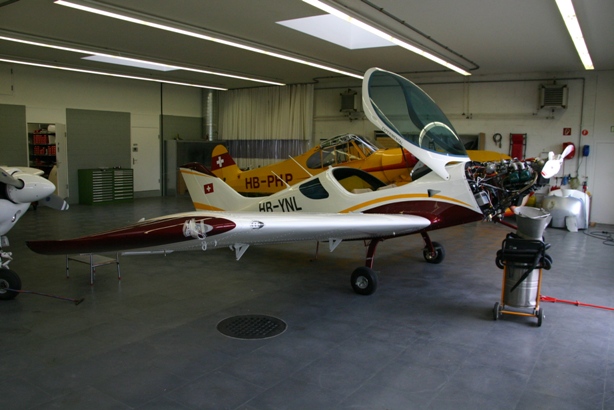
Here what that looks like during measurement. My pump supplies around 0.7 l / minute, with a maximum fuel consumption at full power of 0.45 l / minute. The result is therefore perfectly ok.

After that I did the engine run check, where all engine parameters are recorded at different power setting. I already did that once last week, but I forgot to record some of the environmental conditions so to be sure I did it again. I also went through the list of “common deficiencies” found during final acceptance test. That list is provided by EAS so that builders can avoid the most common mistakes.
05.07.2010: As I have the final project review tomorrow I had to finish a lot of items today. One of them was measuring the engine thrust, for which I could borrow an electronic scale from a fellow builder, which is normally used to measure loads hanging on a rope. To measure the thrust I parked our old airport car on one of our taxi strips and then hooked the plane up to the tow hook of the car. The following photo shows the setup:

The scale is really convenient, as one can attach a remote display to the actual scale head and then have it in the cockpit to do the measurement. The ambient conditions where quite extreme (35 oC), but the EAS form contains a graph from which a correction factor can be derived for compensation. I set the propeller pitch on my Sensenich propeller to a rather cruise oriented setting (4), which still gave sufficient thrust for initial acceleration. The SportCruiser of the club has the same setting.
Later I finished some papers, an finished the compass calibration. I did that already yesterday, but forgot to first calibrate the Dynon sensor, so I had to do that one again.
06.07.2010: Today I had the final project review with my building advisor from the EAS. A lot of paperwork had to be ready, as well as a number of small open issues resolved. One of them was installing all the placards on the panel, and thanks to some tips from Silvan they really look nice. Unfortunately I forgot to take a picture, but that will follow. I also finished the strobes / NAV lights with the exception of the transparent hoods, but I should have them in a week or two.
The final review went well, and there were only a few minor open items in the end, such as a missing bill for the aircraft registration which I had left at home. The most embarrassing one was that I marked the canopy handle the wrong way round (closed in the up instead of down position. I really wonder why I never noticed that before, but I can correct that easily. I hope I will have the open items finished by tomorrow evening, as I see my building advisor again at the board meeting of our club and he could then tick off the last boxes. After that the paper will first go to the EAS for final checking and then to the Swiss Federal Office of Civil Aviation. They will then perform an aircraft review before issuing a permit to fly. The first flight is definitely getting closer…
09.07.2010: I finished most open issues today, including the documentation. It is now in the hands of the EAS for final checking. I also called one of the experts of the Swiss Federal Office of Civil Aviation to discuss possible dates for their final acceptance. He told me that he will soon be on vacation, but might still be able to do it next Saturday! Let’s hope that works out…
17.07.2010: I have spent the last few days finishing all documents that are required for the final inspection by an expert appointed by the Swiss Federal Office of Civil Aviation. That was worth the effort, as the inspection went very well today. I went to the airport early to prepare the plane, which meant installing the wheel pants and removing all access covers. Below the plane as it looked when the inspector arrived.

He then first went through all the paperwork and then made a very detailed inspection of the plane. He only found some minor issues, which I can rectify myself without further check, and after that I can send all papers to the airplane registration office. They will then issue a restricted permit to fly, on which I can do the first flight as well as the flight testing. I should have the paper in two to three weeks, which is fine as I will go on a 10 day business trip from the 25th July to the 5th August.
19.07.2010: I met my flight testing advisor today for the first time. EAS assigns an advisor to each pilot to assist him with the flight testing phase of the project. That’s not bad, as the risk of silly mistakes can be significantly reduced. We went through some paperwork and then discussed the major risks of the first flight. EAS has developed detailed objectives for each test flight, and they have to be ticked off one after the other. During that phase all performance parameters are verified, so that the Airplane Flight Manual can be finalised with truel values at the end of the flight testing phase. Only once that is completed the Swiss Federal Office of Civil Aviation will issue an unrestricted permit to fly.
I also finished all minor items found during the final inspection, so that I can finish the paperwork.
21.07.2010: Today I finished all the paperwork to be sent to the Swiss Federal Office of Civil Aviation. I will to that tomorrow morning, and after that I will have to wait until I receive the permit to start flight testing. That can take anywhere between a few days and a few week’s, so let’s see.
24.07.2010: It took me two more days to send off the documents, but now it’s done. There was a slight confusion regarding the speeds mentioned in the design summary, the documentation of the MTOW increase and the AFM, but that’s clarified and corrected now.